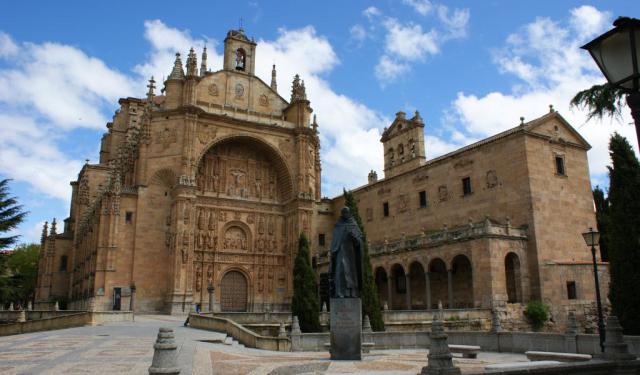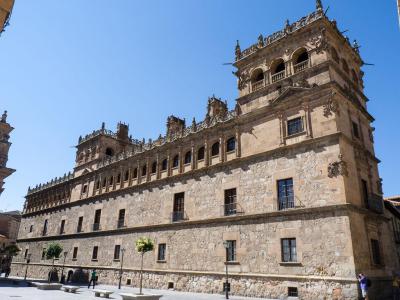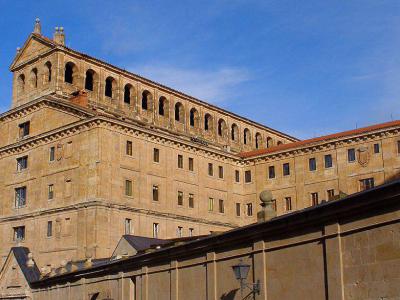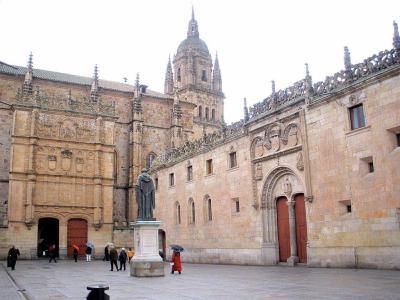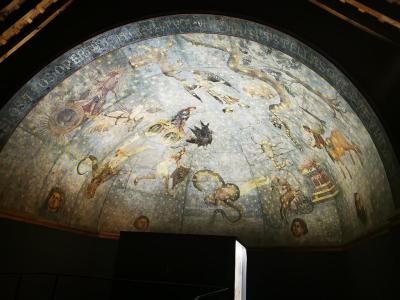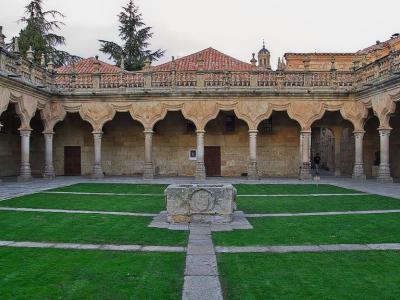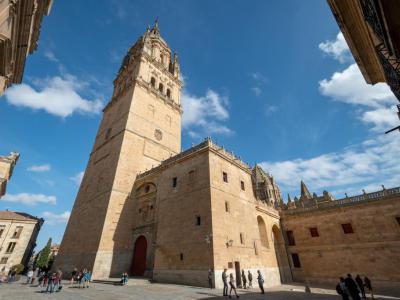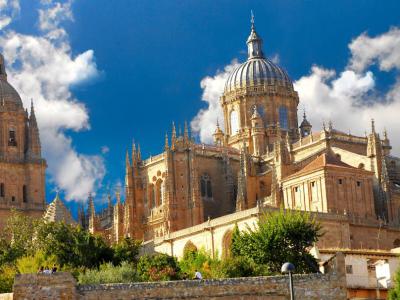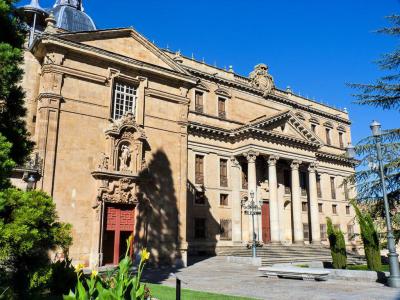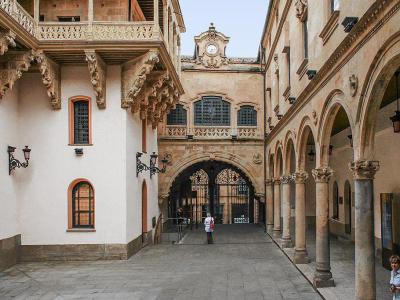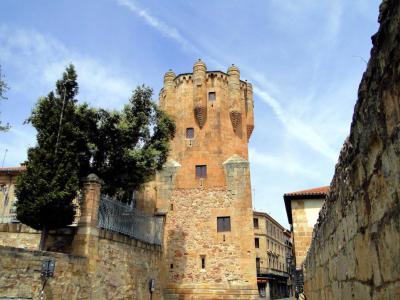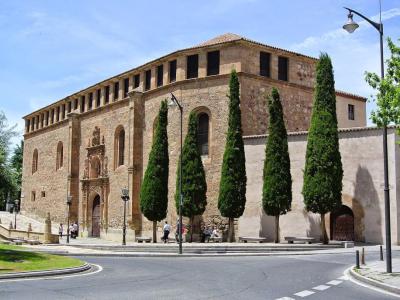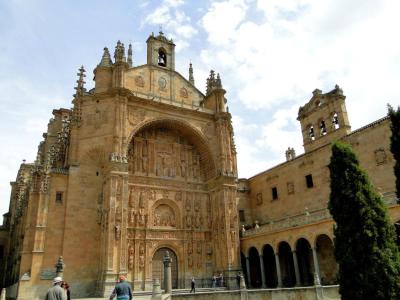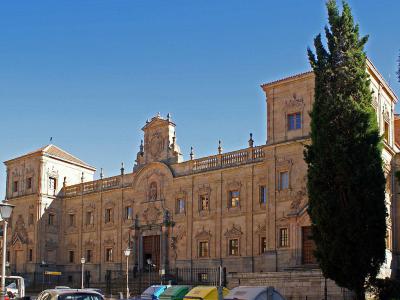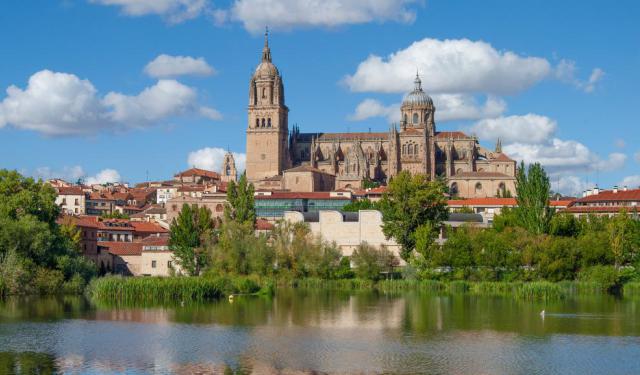Salamanca's Historical Buildings Walking Tour (Self Guided), Salamanca
Salamanca – one of Spain’s most delightful and intriguing destinations – is a treasure trove of architectural marvels. The abundance of well-preserved, centuries-old wonders of construction tucked away in the labyrinth of narrow lanes in this prestigious university city is truly awe-inspiring. A true feast for the eyes, they are so impressive that the entire historic center of Salamanca was declared a UNESCO World Heritage Site in 1988.
Among the standout attractions here are the Old and New Cathedrals, the magnificent examples of Gothic architecture, whose towering spires and intricate façades leave visitors in awe of their grandeur.
Located near the New Cathedral, the Anaya Palace (Palacio de Anaya), home to the Department of Philology of the University of Salamanca, is an elegant 18th-century edifice that combines Baroque and Neoclassical elements.
The University (Universidad Pontificia de Salamanca) itself, one of Europe's oldest educational institutions, is another architectural gem. The iconic “Sky Over Salamanca” (Cielo de Salamanca) mural adorning the entrance hall of the University's Escuelas Menores building, is very much an attraction in its own right.
Other notable sights include the San Esteban Convent (Convento de San Esteban), with its impressive Plateresque façade and beautiful cloisters, and the Monterrey Palace (Palacio de Monterrey), a Renaissance structure characterized by its elegant façade and elaborate decorative elements.
Described as "a flamboyant ballet of styles," the city of Salamanca, indeed, puts up a grand show in which Gothic spires, Renaissance palaces, and Baroque flourishes pirouette together in a perfect ensemble. If you wish to step into Salamanca's architectural embrace and immerse yourself in a world where time stands still, and each arch and column tells a tale of artistic prowess and stone-masonry brilliance, take this self-guided walking tour.
Among the standout attractions here are the Old and New Cathedrals, the magnificent examples of Gothic architecture, whose towering spires and intricate façades leave visitors in awe of their grandeur.
Located near the New Cathedral, the Anaya Palace (Palacio de Anaya), home to the Department of Philology of the University of Salamanca, is an elegant 18th-century edifice that combines Baroque and Neoclassical elements.
The University (Universidad Pontificia de Salamanca) itself, one of Europe's oldest educational institutions, is another architectural gem. The iconic “Sky Over Salamanca” (Cielo de Salamanca) mural adorning the entrance hall of the University's Escuelas Menores building, is very much an attraction in its own right.
Other notable sights include the San Esteban Convent (Convento de San Esteban), with its impressive Plateresque façade and beautiful cloisters, and the Monterrey Palace (Palacio de Monterrey), a Renaissance structure characterized by its elegant façade and elaborate decorative elements.
Described as "a flamboyant ballet of styles," the city of Salamanca, indeed, puts up a grand show in which Gothic spires, Renaissance palaces, and Baroque flourishes pirouette together in a perfect ensemble. If you wish to step into Salamanca's architectural embrace and immerse yourself in a world where time stands still, and each arch and column tells a tale of artistic prowess and stone-masonry brilliance, take this self-guided walking tour.
How it works: Download the app "GPSmyCity: Walks in 1K+ Cities" from Apple App Store or Google Play Store to your mobile phone or tablet. The app turns your mobile device into a personal tour guide and its built-in GPS navigation functions guide you from one tour stop to next. The app works offline, so no data plan is needed when traveling abroad.
Salamanca's Historical Buildings Walking Tour Map
Guide Name: Salamanca's Historical Buildings Walking Tour
Guide Location: Spain » Salamanca (See other walking tours in Salamanca)
Guide Type: Self-guided Walking Tour (Sightseeing)
# of Attractions: 13
Tour Duration: 2 Hour(s)
Travel Distance: 2.3 Km or 1.4 Miles
Author: DanaOffice
Sight(s) Featured in This Guide:
Guide Location: Spain » Salamanca (See other walking tours in Salamanca)
Guide Type: Self-guided Walking Tour (Sightseeing)
# of Attractions: 13
Tour Duration: 2 Hour(s)
Travel Distance: 2.3 Km or 1.4 Miles
Author: DanaOffice
Sight(s) Featured in This Guide:
- Palacio de Monterrey (Monterey Palace)
- Pontifical University of Salamanca
- Hospital del Estudio (Hospital of Study)
- Cielo de Salamanca (Sky Over Salamanca)
- Escuelas Menores (Minor Schools)
- Catedral Vieja de Santa Maria (Old Cathedral of Salamanca)
- Catedral Nueva de Salamanca (New Cathedral of Salamanca)
- Palacio de Anaya (Anaya Palace)
- Palacio de la Salina (Salina Palace)
- Torre del Clavero (Clavero Tower)
- Convento de las Duenas (Duenas Convent)
- Convento de San Esteban (Convent of St. Stephen)
- Colegio de Calatrava (Calatrava College)
1) Palacio de Monterrey (Monterey Palace)
The Monterey Palace is a grand quadrangular edifice with multiple wings and towers, commissioned in 1539 by Alonso de Zúñiga y Acevedo Fonseca, the 3rd Count of Monterrey. It stands as a consummate example of Spanish Renaissance civil architecture, embodying the ornate Plateresque style. Only its southern wing was completed due to financial constraints and the premature death of the count's heir. Despite being unfinished, the building’s crested towers, decorative balconies, and fantasting chimneys remain symbols of Golden Age nobility.
Throughout the 19th and 20th centuries, the Monterey Palace left an mark on Spanish architectural heritage, inspiring the “Monterrey style” seen in buildings like the Archaeological Museum of Seville, the Palencia Provincial Council, and the Cavalry Academy of Valladolid. Its historical and cultural significance was formally recognized when it was declared a National Historic Monument in 1929.
Today, the palace remains part of the House of Alba family’s heritage and even serves as a residence for the Duke of Alba. Following restoration efforts in collaboration with the city of Salamanca and the Casa de Alba Foundation, it opened its doors to the public in May 2018. Visitors can now experience an intimate glimpse of noble life, exploring rooms filled with period furnishings, tapestries, Talavera ceramics, and cherished artworks-including two rare landscapes by José de Ribera, a portrait of the Grand Duke of Alba, works by Salvatore Rosa, and even pieces attributed to Tiziano.
The official tourism portal highlights that the Monterey Palace offers music, narration, and visuals to bring its historic atmosphere to life. One highlight is the panoramic view from its tower, where you can admire the elaborate stone filigree and chimneys up close, along with sweeping vistas of Salamanca’s skyline.
Throughout the 19th and 20th centuries, the Monterey Palace left an mark on Spanish architectural heritage, inspiring the “Monterrey style” seen in buildings like the Archaeological Museum of Seville, the Palencia Provincial Council, and the Cavalry Academy of Valladolid. Its historical and cultural significance was formally recognized when it was declared a National Historic Monument in 1929.
Today, the palace remains part of the House of Alba family’s heritage and even serves as a residence for the Duke of Alba. Following restoration efforts in collaboration with the city of Salamanca and the Casa de Alba Foundation, it opened its doors to the public in May 2018. Visitors can now experience an intimate glimpse of noble life, exploring rooms filled with period furnishings, tapestries, Talavera ceramics, and cherished artworks-including two rare landscapes by José de Ribera, a portrait of the Grand Duke of Alba, works by Salvatore Rosa, and even pieces attributed to Tiziano.
The official tourism portal highlights that the Monterey Palace offers music, narration, and visuals to bring its historic atmosphere to life. One highlight is the panoramic view from its tower, where you can admire the elaborate stone filigree and chimneys up close, along with sweeping vistas of Salamanca’s skyline.
2) Pontifical University of Salamanca
The Pontifical University of Salamanca was established in 1940 by Pope Pius XII, following the abolition of the ecclesiastical faculties of Theology and Canon Law at the University of Salamanca in 1854. It was created as a continuation of those traditions, restoring them within a new institution dedicated to Catholic higher education.
Since its founding, the university has been housed in the former Royal College of the Holy Spirit, commonly known as La Clerecía. Construction of this impressive Baroque structure began in 1617 under the direction of architect Juan Gómez de Mora, commissioned by Queen Margaret of Austria, wife of Philip III. It took over a century to complete, and includes a church façade, twin towers, and a grand dome.
The Courtyard of the Studies within the historic headquarters of La Clerecía, resembles a royal courtyard, adorned with semi-columns, arched galleries, balconies, and notable artworks like the 28 paintings depicting the life of Saint Ignatius by Sebastiano Conca. Visitors can often climb the university’s bell tower, enjoying panoramic views of Salamanca’s skyline. Tours typically include the Main Hall, cloisters, Grand Staircase, and the bell tower with spectacular vistas.
Though relatively new compared to its medieval counterpart, the Pontifical University of Salamanca is home to nearly 6,500 students, operating as a private, non-profit Roman Catholic university. It offers degrees in theology, canon law, philosophy, and related disciplines, both on its main Salamanca campus and at a branch in Madrid.
Since its founding, the university has been housed in the former Royal College of the Holy Spirit, commonly known as La Clerecía. Construction of this impressive Baroque structure began in 1617 under the direction of architect Juan Gómez de Mora, commissioned by Queen Margaret of Austria, wife of Philip III. It took over a century to complete, and includes a church façade, twin towers, and a grand dome.
The Courtyard of the Studies within the historic headquarters of La Clerecía, resembles a royal courtyard, adorned with semi-columns, arched galleries, balconies, and notable artworks like the 28 paintings depicting the life of Saint Ignatius by Sebastiano Conca. Visitors can often climb the university’s bell tower, enjoying panoramic views of Salamanca’s skyline. Tours typically include the Main Hall, cloisters, Grand Staircase, and the bell tower with spectacular vistas.
Though relatively new compared to its medieval counterpart, the Pontifical University of Salamanca is home to nearly 6,500 students, operating as a private, non-profit Roman Catholic university. It offers degrees in theology, canon law, philosophy, and related disciplines, both on its main Salamanca campus and at a branch in Madrid.
3) Hospital del Estudio (Hospital of Study)
Hospital of Study, founded in 1413 under the name Hospital of Saint Thomas Aquinas, served a unique dual purpose: it provided both lodging and medical care for economically disadvantaged university students. This charitable institution held deep backing from both monarchy and university, underscoring the bond between learning, religion, and civic responsibility.
The building's Plateresque portal is rich in symbolism: framed within a double-height alfiz, the doorway features sculptural motifs of Saint Thomas Aquinas, the Virgin, and Archangel Gabriel, culminating above in heraldic shields-Castile and León at the center, flanked by the royal arms of Castile and Aragon with the eagle of Saint John.
Originally aimed at serving students through care and hospitality until 1810, the building’s function evolved over centuries. By the mid-19th century, its chapel housed the University’s historical archives, and in the late 20th century, it became the seat of the University’s government, now home to the Rectorate. Inside, visitors find the Hall of Portraits-once the infirmary-now used for ceremonial and public university events.
The building's Plateresque portal is rich in symbolism: framed within a double-height alfiz, the doorway features sculptural motifs of Saint Thomas Aquinas, the Virgin, and Archangel Gabriel, culminating above in heraldic shields-Castile and León at the center, flanked by the royal arms of Castile and Aragon with the eagle of Saint John.
Originally aimed at serving students through care and hospitality until 1810, the building’s function evolved over centuries. By the mid-19th century, its chapel housed the University’s historical archives, and in the late 20th century, it became the seat of the University’s government, now home to the Rectorate. Inside, visitors find the Hall of Portraits-once the infirmary-now used for ceremonial and public university events.
4) Cielo de Salamanca (Sky Over Salamanca)
Within the courtyard of the Minor Schools at the University of Salamanca, the Sky Over Salamanca is a stunning 15th‑century fresco originally painted by Fernando Gallego in the 1480s. It once adorned the vault of the old university library-now transformed into the Chapel of Saint Jerome-but most of the original structure collapsed during later alterations. Only one-third of the celestial ceiling survived, hidden behind a false ceiling until its rediscovery in 1901.
The surviving fragment-roughly 8.7 meters in diameter-is a richly detailed astrological diagram, painted on a quarter‑sphere vault. It portrays zodiac signs such as Leo, Virgo, Libra, Scorpio, and Sagittarius, alongside constellations like Hydra, Boötes, and Hercules. The Sun and Mercury are represented dramatically-one riding a chariot and the other atop an eagle‑drawn vehicle-reflecting the iconography of the Poeticon Astronomicon, referred in English as “The Poetical Astronomy”.
Far more than decorative art, the fresco is a remarkable artifact of medieval science and education. Influenced by the university's recently established chair of astrology, the fresco likely served as a planetarium for teaching astronomy and medicine-offering students a visual guide to the cosmos and astrological houses. Despite popular belief, it does not represent the actual sky above Salamanca on a specific date-constellations from both hemispheres are depicted together-underscoring its symbolic, not literal, purpose.
Today, visitors can view this preserved fragment in the University Museum housed within the Minor Schools. The fresco, carefully transferred to canvas in the early 1950s, stands as a quiet yet mesmerizing reminder of the Golden Age of intellectual and artistic endeavor in Salamanca.
The surviving fragment-roughly 8.7 meters in diameter-is a richly detailed astrological diagram, painted on a quarter‑sphere vault. It portrays zodiac signs such as Leo, Virgo, Libra, Scorpio, and Sagittarius, alongside constellations like Hydra, Boötes, and Hercules. The Sun and Mercury are represented dramatically-one riding a chariot and the other atop an eagle‑drawn vehicle-reflecting the iconography of the Poeticon Astronomicon, referred in English as “The Poetical Astronomy”.
Far more than decorative art, the fresco is a remarkable artifact of medieval science and education. Influenced by the university's recently established chair of astrology, the fresco likely served as a planetarium for teaching astronomy and medicine-offering students a visual guide to the cosmos and astrological houses. Despite popular belief, it does not represent the actual sky above Salamanca on a specific date-constellations from both hemispheres are depicted together-underscoring its symbolic, not literal, purpose.
Today, visitors can view this preserved fragment in the University Museum housed within the Minor Schools. The fresco, carefully transferred to canvas in the early 1950s, stands as a quiet yet mesmerizing reminder of the Golden Age of intellectual and artistic endeavor in Salamanca.
5) Escuelas Menores (Minor Schools)
The Minor Schools served as the preparatory stage for students entering the higher degrees at the University-covering foundational subjects like grammar, logic, and rhetoric, which were prerequisites to pursue advanced studies in fields such as law, medicine, or theology. These schools played a vital role in equipping students-particularly from less affluent backgrounds-with the scholarly tools needed to advance within the university system.
Although modest in scale, the building’s design exudes Renaissance charm. Its façade features two semicircular arches supported by a granite column with a Corinthian capital, and is crowned by the imperial coat of arms of Charles I. The surrounding courtyard is a serene, one-story cloister framed by gently curving mixtilinear arches, topped by an 18th-century Baroque balustrade.
One of the most iconic treasures hidden within the Minor Schools is the Cielo de Salamanca, meaning Sky of Salamanca, a vaulted astrological fresco painted in the late 15th century. It depicts constellations, zodiac signs, the sun, and Mercury-likely serving an educational role for astronomy or medicine students. Today, it's preserved within a museum space inside the building, offering a glimpse into the scholarly worldview of Salamanca’s Golden Age.
Although the Minor Schools no longer serve their original educational purpose, the complex remains an invaluable heritage site-part educational space, part cultural venue. It now houses exhibitions, academic events, and interpretive installations, continuing its centuries-long tradition as a locus of learning and cultural exchange.
Although modest in scale, the building’s design exudes Renaissance charm. Its façade features two semicircular arches supported by a granite column with a Corinthian capital, and is crowned by the imperial coat of arms of Charles I. The surrounding courtyard is a serene, one-story cloister framed by gently curving mixtilinear arches, topped by an 18th-century Baroque balustrade.
One of the most iconic treasures hidden within the Minor Schools is the Cielo de Salamanca, meaning Sky of Salamanca, a vaulted astrological fresco painted in the late 15th century. It depicts constellations, zodiac signs, the sun, and Mercury-likely serving an educational role for astronomy or medicine students. Today, it's preserved within a museum space inside the building, offering a glimpse into the scholarly worldview of Salamanca’s Golden Age.
Although the Minor Schools no longer serve their original educational purpose, the complex remains an invaluable heritage site-part educational space, part cultural venue. It now houses exhibitions, academic events, and interpretive installations, continuing its centuries-long tradition as a locus of learning and cultural exchange.
6) Catedral Vieja de Santa Maria (Old Cathedral of Salamanca) (must see)
The Old Cathedral of Salamanca, officially the Cathedral of Saint Mary, is a solemn survivor of medieval devotion and artistry—its stones whispering stories that predate the city’s Renaissance glory. Founded in 1120 by Bishop Jerome of Périgord, the cathedral rose slowly over two centuries, marking the transition between the solid strength of Romanesque style and the early grace of Gothic design. When King Ferdinand II deemed it “small, dark, and low” in the early 1500s, plans began for a new cathedral beside it—but the old one was never torn down, allowing both temples to coexist like two eras standing shoulder to shoulder.
Inside, time seems suspended. Golden light spills through narrow windows onto frescoes that narrate the life of the Virgin Mary and Christ, culminating in a haunting Last Judgment painted by Nicolás Florentino. One of its treasures is the Tower of the Rooster, named for the weather vane perched atop its conical dome. Locals say the rooster protects the city, and when the wind turns it sharply, it warns of storms—or mischief—approaching Salamanca.
Legends intertwine with history here. In the Chapel of Santa Bárbara, university students once faced the most daunting test of their academic lives: their doctoral examination. Locked inside overnight to prepare, they would emerge at dawn—those who passed through the grand portal, and those who failed through a smaller side door, heads bowed. The practice turned the cathedral into a theater of ambition, humility, and resilience.
Though centuries have passed, the Old Cathedral endures as the spiritual heart of Salamanca. Its cloisters now house a museum, and from the adjoining tower, visitors can look down upon the intimate medieval church and the monumental New Cathedral beyond it. The contrast captures the essence of Salamanca itself—a city where faith, scholarship, and legend intertwine, and where even a weathered rooster keeps watch over eight hundred years of human striving.
Inside, time seems suspended. Golden light spills through narrow windows onto frescoes that narrate the life of the Virgin Mary and Christ, culminating in a haunting Last Judgment painted by Nicolás Florentino. One of its treasures is the Tower of the Rooster, named for the weather vane perched atop its conical dome. Locals say the rooster protects the city, and when the wind turns it sharply, it warns of storms—or mischief—approaching Salamanca.
Legends intertwine with history here. In the Chapel of Santa Bárbara, university students once faced the most daunting test of their academic lives: their doctoral examination. Locked inside overnight to prepare, they would emerge at dawn—those who passed through the grand portal, and those who failed through a smaller side door, heads bowed. The practice turned the cathedral into a theater of ambition, humility, and resilience.
Though centuries have passed, the Old Cathedral endures as the spiritual heart of Salamanca. Its cloisters now house a museum, and from the adjoining tower, visitors can look down upon the intimate medieval church and the monumental New Cathedral beyond it. The contrast captures the essence of Salamanca itself—a city where faith, scholarship, and legend intertwine, and where even a weathered rooster keeps watch over eight hundred years of human striving.
7) Catedral Nueva de Salamanca (New Cathedral of Salamanca) (must see)
The New Cathedral of Salamanca tells a story that begins with royal impatience and ends in local devotion. In 1509, King Ferdinand II of Aragon, unimpressed by the “small, dark, and low” Romanesque cathedral beside the Tormes River, summoned architects from Toledo and Seville to design a new temple worthy of Salamanca’s growing prestige. Construction began in 1513, a project so ambitious it would not be completed for more than two centuries—its stones aging and styles evolving with time.
The result is a breathtaking hybrid: part Gothic, part Renaissance, and part Baroque—a cathedral that seems to embody Spain’s transformation across the ages. It was built parallel to the Old Cathedral, allowing both to coexist in harmony. Though interrupted by wars, economic troubles, and even the Lisbon earthquake of 1755, which cracked its dome and tilted its tower, the people of Salamanca refused to abandon their great work. The building stood firm, a miracle the townspeople would never forget.
Out of that miracle grew one of Salamanca’s most cherished traditions. When the earthquake struck, terrified citizens rushed inside the cathedral seeking divine protection—and survived without harm. In gratitude, the cathedral’s caretakers vowed that each October 31st, a member of the Mariquelo family would climb to the top of the tower to ring the bells and thank God. For centuries, the ritual endured, the Mariquelo scaling dizzying heights while the crowd below prayed and sang. Revived again in the 1980s, it remains a symbol of the city’s resilience and faith.
Today, visitors marvel not only at the cathedral’s glowing sandstone and celestial ceilings but also at the quirky modern astronaut carving hidden on its façade—a playful touch linking past and present. The New Cathedral stands as both sanctuary and storyteller, reminding all who enter that in Salamanca, faith and time are still measured in stone and sound.
The result is a breathtaking hybrid: part Gothic, part Renaissance, and part Baroque—a cathedral that seems to embody Spain’s transformation across the ages. It was built parallel to the Old Cathedral, allowing both to coexist in harmony. Though interrupted by wars, economic troubles, and even the Lisbon earthquake of 1755, which cracked its dome and tilted its tower, the people of Salamanca refused to abandon their great work. The building stood firm, a miracle the townspeople would never forget.
Out of that miracle grew one of Salamanca’s most cherished traditions. When the earthquake struck, terrified citizens rushed inside the cathedral seeking divine protection—and survived without harm. In gratitude, the cathedral’s caretakers vowed that each October 31st, a member of the Mariquelo family would climb to the top of the tower to ring the bells and thank God. For centuries, the ritual endured, the Mariquelo scaling dizzying heights while the crowd below prayed and sang. Revived again in the 1980s, it remains a symbol of the city’s resilience and faith.
Today, visitors marvel not only at the cathedral’s glowing sandstone and celestial ceilings but also at the quirky modern astronaut carving hidden on its façade—a playful touch linking past and present. The New Cathedral stands as both sanctuary and storyteller, reminding all who enter that in Salamanca, faith and time are still measured in stone and sound.
8) Palacio de Anaya (Anaya Palace)
Palacio de Anaya (Anaya Palace) is one of the few buildings in Salamanca in neoclassical style. It owes its name to Diego de Anaya Maldonado, founder of the Colegio de San Bartolomé in 1401. Its works began in 1760, to replace the previous building of the Colegio Mayor de San Bartolomé, badly damaged in the Lisbon earthquake of 1755. Its creators were José from Hermosilla and Juan de Sagarvinaga. Its most striking elements are the façade and the imperial staircase inside the palace, where there is also an interesting bust of Miguel de Unamuno, made by Victorio Macho in 1930.
After the suppression of the university colleges, the building had various uses, including Civil Government, which is why it is currently known as a palace, although it is actually a college.
The Anaya Palace currently houses the Faculty of Philology of the University of Salamanca.
Next to the school is the Hospedería, 1715, by Joaquín Churriguera, which housed students who paid for their studies by serving other noble and wealthy students who occupied the College. Today it is used for classrooms and offices, and its old stables house the Faculty cafeteria.
The baroque church of San Sebastián, formerly the school chapel and currently the Cathedral Parish, is also attached.
After the suppression of the university colleges, the building had various uses, including Civil Government, which is why it is currently known as a palace, although it is actually a college.
The Anaya Palace currently houses the Faculty of Philology of the University of Salamanca.
Next to the school is the Hospedería, 1715, by Joaquín Churriguera, which housed students who paid for their studies by serving other noble and wealthy students who occupied the College. Today it is used for classrooms and offices, and its old stables house the Faculty cafeteria.
The baroque church of San Sebastián, formerly the school chapel and currently the Cathedral Parish, is also attached.
Sight description based on Wikipedia.
9) Palacio de la Salina (Salina Palace)
The Salina Palace in Salamanca is one of those places where beauty and rumor intertwine. Built in 1538 for Rodrigo de Messía, Count of Barajas and the city’s corregidor, it was originally designed to house the salt trade—one of the most valuable goods of its time. Yet behind its stately Renaissance façade lies a far more human story.
According to local legend, Rodrigo’s wife, tormented by jealousy, commissioned the palace’s sculptor to carve grotesque faces, grimaces, and mythical figures into the courtyard’s stonework. Each expression, she claimed, represented the unfaithful husband’s supposed lovers, ensuring that their mockery would haunt him for eternity. Whether true or not, the story gives the courtyard an unmistakable air of mystery—those faces seem to watch you as you move, amused or reproachful, as if still savoring the domestic drama that gave them life.
Over the centuries, the palace has stood witness to Salamanca’s evolving identity. Once filled with salt merchants and noble guests, it now houses the Provincial Council of Salamanca, yet its Renaissance courtyard remains a quiet refuge for those drawn to art and legend. Exhibitions and cultural events occasionally fill its arcades, but the essence of the place lies in its silence—the kind that lets you hear whispers from another time.
Visiting the Salina Palace is like opening a private diary of the Renaissance: restrained elegance on the surface, but beneath it, emotions, vanity, and humor immortalized in stone.
According to local legend, Rodrigo’s wife, tormented by jealousy, commissioned the palace’s sculptor to carve grotesque faces, grimaces, and mythical figures into the courtyard’s stonework. Each expression, she claimed, represented the unfaithful husband’s supposed lovers, ensuring that their mockery would haunt him for eternity. Whether true or not, the story gives the courtyard an unmistakable air of mystery—those faces seem to watch you as you move, amused or reproachful, as if still savoring the domestic drama that gave them life.
Over the centuries, the palace has stood witness to Salamanca’s evolving identity. Once filled with salt merchants and noble guests, it now houses the Provincial Council of Salamanca, yet its Renaissance courtyard remains a quiet refuge for those drawn to art and legend. Exhibitions and cultural events occasionally fill its arcades, but the essence of the place lies in its silence—the kind that lets you hear whispers from another time.
Visiting the Salina Palace is like opening a private diary of the Renaissance: restrained elegance on the surface, but beneath it, emotions, vanity, and humor immortalized in stone.
10) Torre del Clavero (Clavero Tower)
Rising approximately 28 meters high, the Clavero Tower was constructed in the second half of the 15th century as part of the palace of Don Francisco de Sotomayor, a high-ranking Clavero Mayor of the Order of Alcántara. The name "Clavero" itself refers to this title, meaning he was entrusted with the keys and archives of his order.
One of the tower’s most captivating features is its unusual form: a sturdy square base transitions smoothly into an eight-sided upper section about twenty meters above ground. Around its upper tier are eight semi-cylindrical turrets-known as garitas-each ornately decorated and topped with heraldic shields. The cornice is lined with blind arches and modillions-classic Gothic decorative motifs.
Though it perhaps suggests a defensive structure, the tower’s height and design indicate that it was more a symbol of noble prestige than a martial stronghold. Some historians suggest it was part of a civil urban palace, possibly echoing designs like the tower of Belalcázar Castle, rather than serving any real fortification function.
Declared a national monument on June 3, 1931, it's one of the few remnants of noble fortifications in the city along with the Tower of the Air. In 1943, the tower was donated to the municipal government and later became home to offices for Salamanca’s provincial government and cultural institutions. Although public access inside is limited, its exterior continues to enchant visitors.
One of the tower’s most captivating features is its unusual form: a sturdy square base transitions smoothly into an eight-sided upper section about twenty meters above ground. Around its upper tier are eight semi-cylindrical turrets-known as garitas-each ornately decorated and topped with heraldic shields. The cornice is lined with blind arches and modillions-classic Gothic decorative motifs.
Though it perhaps suggests a defensive structure, the tower’s height and design indicate that it was more a symbol of noble prestige than a martial stronghold. Some historians suggest it was part of a civil urban palace, possibly echoing designs like the tower of Belalcázar Castle, rather than serving any real fortification function.
Declared a national monument on June 3, 1931, it's one of the few remnants of noble fortifications in the city along with the Tower of the Air. In 1943, the tower was donated to the municipal government and later became home to offices for Salamanca’s provincial government and cultural institutions. Although public access inside is limited, its exterior continues to enchant visitors.
11) Convento de las Duenas (Duenas Convent)
Founded by Juana Rodríguez de Monroy, a Castilian noblewoman, the Duenas Convent emerged from the noblewoman’s own palace, which she generously donated to Dominican nuns as a retreat for devout women of high birth-hence the moniker “Las Dueñas”, meaning The Noble Ladies. The original Mudejar-style elements of the palace, such as horseshoe arches and decorative tiles, remain visible in spots like the upper cloister, lending a distinctive architectural heritage to the site.
The convent was built in 1419 and around 1533, it expanded significantly with the construction of its church and cloister. Built by Dominican friar Martín de Santiago, the church features a single Gothic nave capped with rib‑vaulted ceilings and concludes with an apse framed by a Baroque altarpiece. Yet the true architectural jewel lies in the convent’s cloister-an irregular, pentagonal two‑level structure that had to adapt to pre-existing walls and corridors.
The lower galleries boast segmental arches supported by slender columns, with intricately carved medallions in the spandrels. The upper galleries are framed by classical lintels, columns, and sculpted footings, while the caps display imaginative and fantastical motifs-monsters and grotesques among them-making this cloister a standout example of Plateresque ornamentation. Remarkably, the Duenas Convent remains an active home for Dominican nuns, preserving its historical purpose as a spiritual retreat.
The convent was built in 1419 and around 1533, it expanded significantly with the construction of its church and cloister. Built by Dominican friar Martín de Santiago, the church features a single Gothic nave capped with rib‑vaulted ceilings and concludes with an apse framed by a Baroque altarpiece. Yet the true architectural jewel lies in the convent’s cloister-an irregular, pentagonal two‑level structure that had to adapt to pre-existing walls and corridors.
The lower galleries boast segmental arches supported by slender columns, with intricately carved medallions in the spandrels. The upper galleries are framed by classical lintels, columns, and sculpted footings, while the caps display imaginative and fantastical motifs-monsters and grotesques among them-making this cloister a standout example of Plateresque ornamentation. Remarkably, the Duenas Convent remains an active home for Dominican nuns, preserving its historical purpose as a spiritual retreat.
12) Convento de San Esteban (Convent of St. Stephen)
The Convent of Saint Stephen is a Dominican monastery whose current structure was built between 1524 and 1610 on the site of a former 13th-century convent. Initiated by Cardinal Friar Juan Álvarez de Toledo, its construction involved celebrated architects-Juan de Álava laid the original plans, followed by Martín de Santiago and Rodrigo Gil de Hontañón, who completed key elements like the transept and dome.
The façade of the convent is a masterpiece of Plateresque art, artfully organized in three vertical tiers and three horizontal levels, resembling an intricate retablo. It features reliefs by Juan Antonio Ceroni depicting the martyrdom of Saint Stephen and the Calvary, all surrounded by symbolic medallions, vegetative motifs, and heraldic shields-an emblem of Counter-Reformation ideals and Dominican authority. While Plateresque ornament dominates, echoes of late Gothic and emerging Baroque styles are visible, reflecting the prolonged construction period.
Inside, the convent church follows a Latin‑cross layout with a single, soaring nave and a domed transept. The real highlight is the monumental main altarpiece, crafted by José Benito de Churriguera in 1692–1693. This towering Baroque marvel, enriched with gilding and Solomonic columns, contains sculpted saints and a central painting by Claudio Coello depicting Saint Stephen’s martyrdom-its richness typical of Spanish Baroque exuberance.
The convent also boasts the elegant Cloister of the Kings, designed by Fray Martín de Santiago. This two-story cloister blends Gothic rib vaults below with a wooden artesonado upper gallery, where medallions depict Old Testament prophets and scenes from Christ’s infancy-forming a “figurative Bible” for the faithful.
The façade of the convent is a masterpiece of Plateresque art, artfully organized in three vertical tiers and three horizontal levels, resembling an intricate retablo. It features reliefs by Juan Antonio Ceroni depicting the martyrdom of Saint Stephen and the Calvary, all surrounded by symbolic medallions, vegetative motifs, and heraldic shields-an emblem of Counter-Reformation ideals and Dominican authority. While Plateresque ornament dominates, echoes of late Gothic and emerging Baroque styles are visible, reflecting the prolonged construction period.
Inside, the convent church follows a Latin‑cross layout with a single, soaring nave and a domed transept. The real highlight is the monumental main altarpiece, crafted by José Benito de Churriguera in 1692–1693. This towering Baroque marvel, enriched with gilding and Solomonic columns, contains sculpted saints and a central painting by Claudio Coello depicting Saint Stephen’s martyrdom-its richness typical of Spanish Baroque exuberance.
The convent also boasts the elegant Cloister of the Kings, designed by Fray Martín de Santiago. This two-story cloister blends Gothic rib vaults below with a wooden artesonado upper gallery, where medallions depict Old Testament prophets and scenes from Christ’s infancy-forming a “figurative Bible” for the faithful.
13) Colegio de Calatrava (Calatrava College)
The College of the Immaculate Conception of Calatrava stands as the only surviving collegiate building in the city established by one of Spain’s military orders, the Order of Calatrava. Founded in 1552 by decree of Emperor Charles V, it was quickly incorporated into the prestigious University of Salamanca by 1554. Yet, the grand edifice we admire today took shape much later, with its construction commencing in 1717 under architect Joaquín de Churriguera, who guided the project until his passing in 1724.
Over the decades, the building's evolution reflected changing tastes and intentions. Work resumed in 1750 under Jerónimo García de Quiñones, at a time when neoclassical aesthetics were in vogue. To align with contemporary style and under the influence of then-rector Francisco Ibáñez de Corbera, much of the original Baroque ornamentation was removed, culminating in the church’s consecration in 1790. The building's facade, composed of two levels framed by giant pilasters and topped with a dignified balustrade, blends Renaissance inspiration with subtle, lingering Baroque details-seen especially in the curved forms around the entrance and window moldings.
Inside, the building experienced dramatic loss during the Spanish War of Independence: several paintings by Francisco de Goya, including a prominent depiction of the Immaculate Conception in the chapel’s high altarpiece, vanished in the upheaval of conflict. Later, the building transitioned from its original academic and spiritual function to serve successive diocesan roles-first as a minor seminary, then a major seminary-before being largely underutilized due to declining vocations.
Today, the college has found new life as the House of the Church, the seat of the Diocese of Salamanca. Following a major renovation between 2000 and 2003, it now houses diocesan offices, a residence, library, auditorium, chapel, and meeting facilities-becoming once more a center for community and ecclesiastical activity.
Over the decades, the building's evolution reflected changing tastes and intentions. Work resumed in 1750 under Jerónimo García de Quiñones, at a time when neoclassical aesthetics were in vogue. To align with contemporary style and under the influence of then-rector Francisco Ibáñez de Corbera, much of the original Baroque ornamentation was removed, culminating in the church’s consecration in 1790. The building's facade, composed of two levels framed by giant pilasters and topped with a dignified balustrade, blends Renaissance inspiration with subtle, lingering Baroque details-seen especially in the curved forms around the entrance and window moldings.
Inside, the building experienced dramatic loss during the Spanish War of Independence: several paintings by Francisco de Goya, including a prominent depiction of the Immaculate Conception in the chapel’s high altarpiece, vanished in the upheaval of conflict. Later, the building transitioned from its original academic and spiritual function to serve successive diocesan roles-first as a minor seminary, then a major seminary-before being largely underutilized due to declining vocations.
Today, the college has found new life as the House of the Church, the seat of the Diocese of Salamanca. Following a major renovation between 2000 and 2003, it now houses diocesan offices, a residence, library, auditorium, chapel, and meeting facilities-becoming once more a center for community and ecclesiastical activity.
Walking Tours in Salamanca, Spain
Create Your Own Walk in Salamanca
Creating your own self-guided walk in Salamanca is easy and fun. Choose the city attractions that you want to see and a walk route map will be created just for you. You can even set your hotel as the start point of the walk.
Salamanca Introduction Walking Tour
Usually, frogs inhabit marshy lands, not the sun-baked plains of central Spain. Yet Salamanca is the exception. The small stone frog adorning the façade of the University of Salamanca keeps a watchful eye over visitors. Local legend says that if you find the frog among the carvings, fate will one day bring you back to the city.
The name Salamanca is rooted in antiquity. One theory links it to... view more
Tour Duration: 1 Hour(s)
Travel Distance: 1.6 Km or 1 Miles
The name Salamanca is rooted in antiquity. One theory links it to... view more
Tour Duration: 1 Hour(s)
Travel Distance: 1.6 Km or 1 Miles
The Most Popular Cities
/ view all
